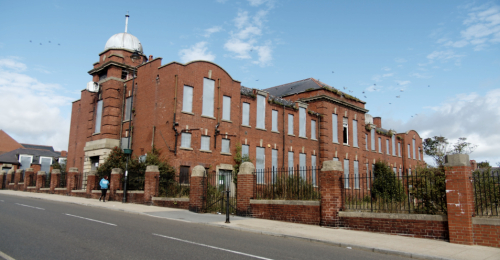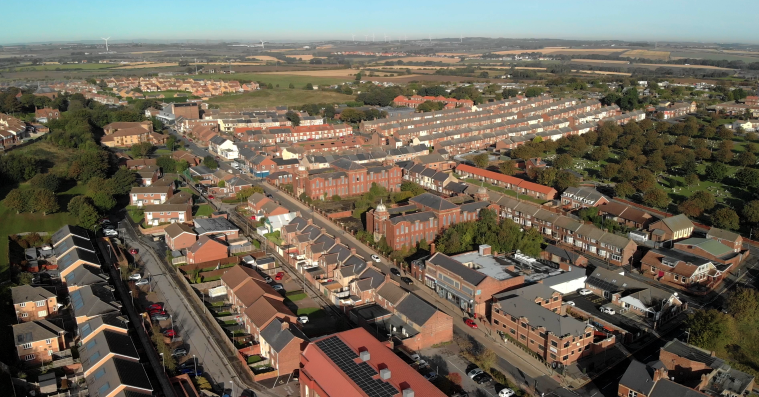'A powerful political statement about the betrayal of the working class': Review of 'The School on Seaside Lane'

Jack Clarke reviews the short film The School on Seaside Lane, directed by Carl Joyce
‘Our only hope for history is for the memories to last.’
This sentiment lies at the heart of The School on Seaside Lane, a short documentary that plunges us into the depths of Easington Colliery, a village shackled by its industrial past and fractured present.
Easington Colliery’s story is a grim reflection of Britain's industrial decline. Once an animated mining community in County Durham, it thrived on the hard labour of its miners, whose lives were deeply intertwined with the pit that lay at the village’s core. The coal mine wasn’t just a workplace; it was the lifeblood of the community, a source of pride and identity. This all came to a halt on 7 May 1993, when the pit was demolished.
This event displaced thousands of workers, shattering the community's spirit and leaving an indelible mark on its collective psyche. The aftermath was a slow, agonising descent into decay, a cruel reminder of promises broken and futures abandoned. The town’s lifeblood was drained, leaving behind a ghostly shell of what once was – a stark testament to the harsh realities of industrial decline and the relentless march of economic ‘progress.’

Carl Joyce’s film opens with sweeping drone shots of a landscape littered with decay, rundown buildings standing as stark monuments to a bygone era. These visuals immediately conjured memories of my own childhood in Salford, on the Kersal Estate, where the shadows of closed factories and abandoned estates loomed large over our daily lives. The raw, unfiltered essence of a community left to rot is captured with mesmerising precision. The now-demolished school on Seaside Lane stands as a poignant relic of better times, its walls whispering tales of a once-thriving community.
Through interviews with the locals, Carl Joyce paints a vivid picture of a place where hope has been systematically stripped away. One interviewee described the area as an ‘eyesore and a disgrace,’ a sentiment that resonated deeply with me as I thought of the neglected corners of my own hometown. These are places where poverty, disillusionment, and a sense of abandonment hang heavy in the air, much like the suffocating fog that used to roll in from the factories in Salford.

The film doesn’t just document physical decay; it delves into the emotional and social toll of such neglect. One poignant sequence overlays poetic narration with haunting images of the school's derelict interiors. The poetry speaks of the eradication of working-class history, a theme handled with both grace and gravity. The camera lingers on broken windows and crumbling walls, capturing the silent screams of a forgotten generation.
‘Hollywood thought Easington was good enough, but nobody else did, I suppose,’ says an interviewee, referring to Billy Elliot (2000) which used the village as a location. This quote struck a chord, the glamour of Hollywood cannot mask the enduring pain of a community’s collapse. The juxtaposition of Easington's momentary spotlight with its prolonged suffering is a powerful commentary on the superficiality of such attention.
The film captures this duality, showcasing the resilience and enduring spirit of working-class communities, but it also reveals a harsh truth: Easington isn't rebuilding; it’s stuck in yesterday. A vivid picture is painted of a village caught in a time warp, where the past looms large and the future seems perpetually out of reach. The characters reflect this stagnation, speaking of lost opportunities, forgotten promises, and a sense of abandonment that has calcified over the years.
This isn’t just a story of local decline; it’s a powerful political statement about systemic neglect and the betrayal of the working class. The dismantling of industrial Britain, driven by political agendas and economic shifts which left places like Easington to fend for themselves. The pit closures, meant to pave the way for a new economic dawn, instead plunged these communities into darkness. Promised regeneration and investment never materialised, leaving behind a landscape of decay and disillusionment.

The School on Seaside Lane challenges us to confront these uncomfortable truths. It demands that we acknowledge the enduring impact of industrial decline and the necessity for genuine, sustained efforts to revitalise these forgotten communities. This film is not just a reflection on the past; it’s a call to action for a more equitable and compassionate future. In a world where the voices of the working class are often drowned out by the din of political rhetoric and economic jargon, The School on Seaside Lane stands as a stark reminder of the harsh realities faced by communities that have been left behind. It raises questions about the enduring impact of these stories and whether simply bearing witness to their struggles is enough.
Behind every boarded-up window and crumbling wall lies a history worth remembering, yet the film leaves us pondering: is it merely a testament to a past that cannot be revived, or can it spark a meaningful change for the future?

Jack Clarke
Jack Clarke is an award-winning, independent film producer who lives in Salford. He can be contacted via his email jack@seriousfeather.com or his X/Twitter account @ClarkeJ98.
